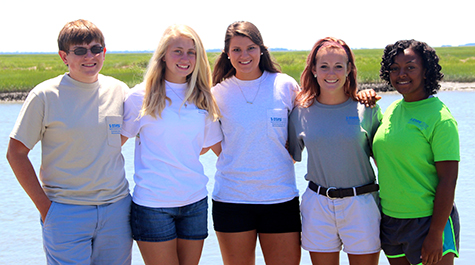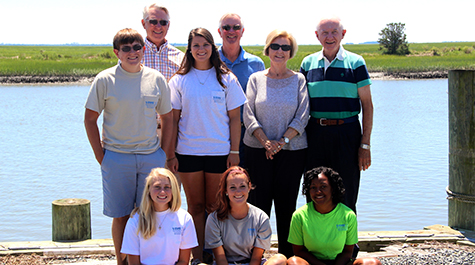Summer interns complete marine research at Eastern Shore Lab
Five students from the Eastern Shore of Virginia had the opportunity to spend their summer pursuing research at the Virginia Institute of Marine Science’s Eastern Shore Laboratory in Wachapreague.
The interns—three college sophomores and two high-school seniors—were Kelsey Bisker (Franktown, Clemson University); Tyler Chandler (Melfa, Nandua High School); Nequa Griffin (Exmore, Virginia Commonwealth University); Grace Holmes (Craddockville, Virginia Commonwealth University); and Sarah Puchalski (Wachapreague, Nandua High School).
“This year’s interns were up against the deepest and most competitive applicant pool we’ve had to date, which makes them the cream of the crop,” says P.G. Ross, acting director of the ESL. “We’re happy we could provide them with the chance to gain summer research experience, and help them decide if a career in marine science is something they want to pursue.”
The paid internship program is entirely funded by private donations. Private donors are Marsha and Rick Amory; Cynthia Bailey; Chris and Kirkie Bosworth; Barbara and Steve Johnsen; the E. Polk Kellam Foundation; E. Polk Kellam, Jr. and Roberta Kellam; Caramine Kellam; Lucius and Tata Kellam; Deborah and Peter Lalor; Page and Tom Young; H.M. Terry Company, Inc.; J.C. Walker Brothers, Inc.; Mary Stoddard; and Dr. Lucy Spigel Herman.
Griffin, a rising sophomore at VCU, says “I’ve learned so much this summer, and I’m so thankful for the donors for giving me the opportunity to learn, have fun, and make money. The experience has been priceless.”
Griffin worked with VIMS Professor Rich Brill and Ph.D. student Sunkita Howard from the University of Otago on a research project titled Bycatch Reduction in Elasmobranch Fish by Means of Weak Electricity, which involved determining the characteristics of an electric field that best keep sharks from removing bait from longline fishing gear, and seeing if sharks’ behavioral responses are due to electrosensory detection.
Also a rising sophomore at VCU, Holmes says because of the rising cost of college tuition, she was thrilled to get accepted into a paid internship. “There’s no way I could’ve done such an interesting, résumé-building internship without being paid, so for that I’m very thankful.”
Holmes worked with Ross on a research project titled Spatial and Temporal Characteristics of Epifauna in a Coastal Lagoon. The ongoing project aims to record settlement of oyster spat off the coast of Wachapreague, providing important data on timing and intensity of oyster spawning. “Data on general settlement tiles provides a background of organism patterns for this area that have not previously existed,” says Holmes. “This is important to oyster restoration efforts and aquaculture.”
Chandler, a rising senior at Nandua High School, also chose study oysters. His project, Linking Structural and Functional Characteristics of Restored Oyster Reefs, aimed to determine levels of nitrogen and phosphorous in communities of oyster and other macrofauna, to gauge how the structural characteristics of oyster reefs affect denitrification, and to determine if there’s a relationship between the reefs’ structural and functional parameters. He worked closely with VIMS Assistant Research Scientist Lisa Kellogg and other researchers at VIMS, The University of Maryland Center for Environmental Studies, and The Nature Conservancy.
“This summer has been a dream come true for me,” says Chandler. “I’ve learned so much, and without this internship I probably would’ve spent my summer sitting at home all day. I’m so thankful to the donors for making this dream a reality.”
Sarah Puchalski, Chandler’s classmate at Nandua, was selected for the internship for the second year in a row. She says the experience has taught her leadership skills and responsibility. “As a returning intern, I was very happy to help the other interns since I was already familiar with the ESL and the staff,” she says.
Puchalski chose to work on a project titled Mechanisms in the Contraction of Shark and Skate Hearts. She worked with Brill and other researchers to investigate the role of calcium in the heart of dogfish, skates, and sandbar sharks, with an overall goal of better describing the physiology of these species.
“I want to thank the donors for another amazing summer,” says Puchalski. “My favorite part about the program is the bond that forms between the interns, and our chemistry was amazing this year.”
Bisker, a rising sophomore at Clemson, worked with a team of researchers on a project titled Restoration of Bay Scallops in the Coastal Bays of Virginia. The project is part of a long-term effort to help Bay scallops—which have seen a strong decline in population since 1932—become a self-sustaining population.
“I came into this internship without the slightest interest in bivalves and watching them grow,” says Bisker. “Now I feel like I will be going back to school as a master at using a microscope. I’m so thankful for this opportunity and the experience I gained.”
VIMS’ Eastern Shore Lab is located on a 5-acre site in a facility that affords education and research opportunities not available anywhere else in the region. The lab offers the opportunity for instructors and students from VIMS, William & Mary, numerous other colleges and universities in Virginia, other states, and even other countries to use the field station for classes. An important part of the Virginia Institute of Marine Science, the ESL also plays a major role in the Eastern Shore economy.
The ESL offers a variety of public-education activities throughout the year, in addition to two undergraduate field courses currently offered through VIMS’ School of Marine Science. In addition to working on research projects, the summer interns participate in some of the educational programs offered at the lab during the summer.



